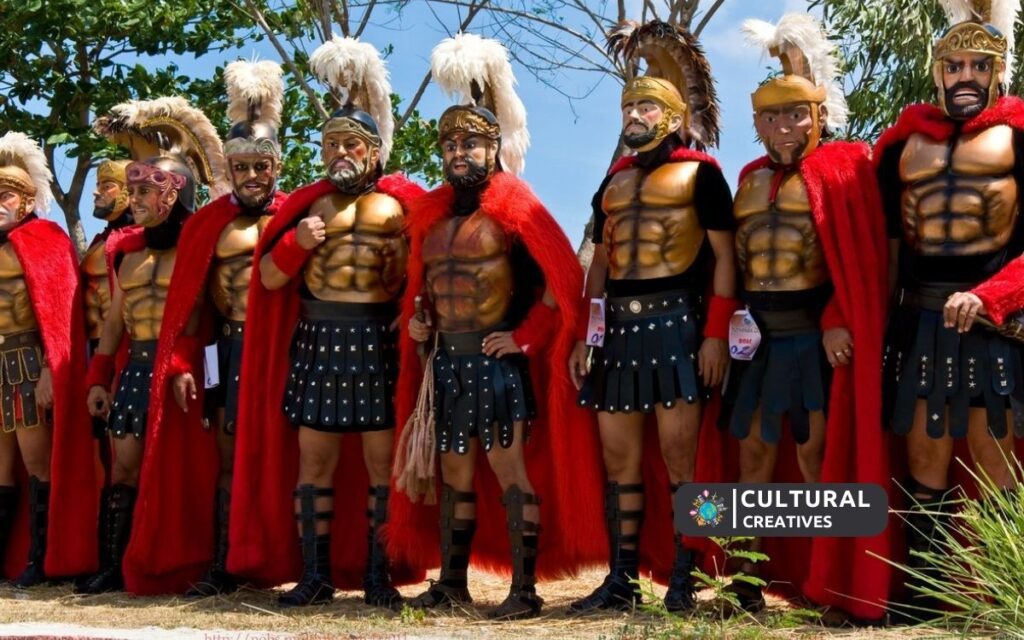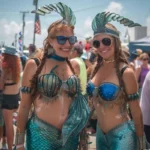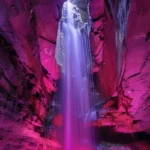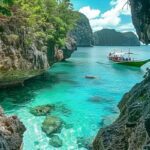The Moriones Festival is an annual Filipino religious festival held during Holy Week in Marinduque. It features colorful, warrior-like masks and costumes depicting Roman soldiers.
The Moriones Festival is steeped in both culture and tradition, drawing thousands of visitors to Marinduque each year. Commemorating the life and experiences of Saint Longinus, a Roman centurion, the revelers dress, handcrafted masks and regalia, transforming the locale into an open-air theater of biblical reenactment.
Participants, known as ‘Moriones,’ wear these masks throughout the week, participating in a series of events that blend religious observance with street pageantry. The festival culminates in a dramatic reenactment of Longinus’s beheading, capturing the attention of spectators with its gripping theatrics. A fusion of faith and Filipino cultural heritage, this event echoes the island’s rich historical tapestry and offers a glimpse into the spirited communal life of Marinduque.
Moriones Festival Place Of Origin
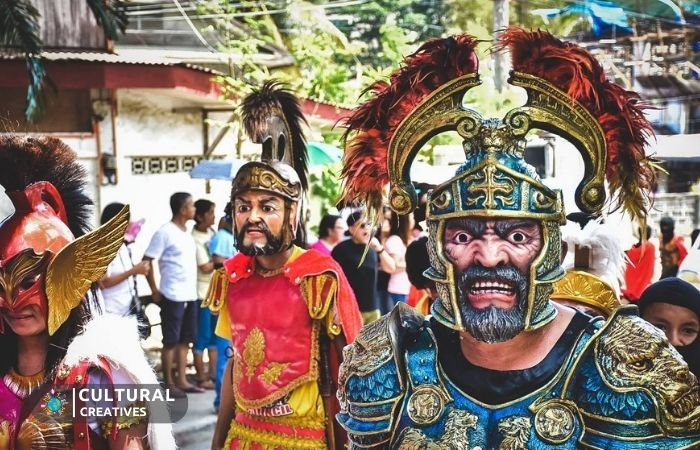
The roots of the Moriones Festival can be traced back to the island of Marinduque. This unique tradition began in the 19th century as a local interpretation of the Passion of Christ. It centers on the story of Longinus, a Roman centurion who was blind in one eye and who, according to legend, gained back his sight when blood from the crucified Christ spurt on his eye. Over time, the festival has not only captured the imaginations of the local population but has also captured the hearts of visitors from around the globe.
The Moriones In Filipino Culture
The Moriones Festival transcends its religious roots to reflect the intricate fusion of history, culture, and spirituality in the Philippines. It is a powerful representation of the enduring piety of the Filipino people, their craftsmanship in mask and costume-making, and their penchant for storytelling. These masks, known as Moriones, symbolize both penance and celebration. They are a pinnacle of Filipino artistry, each piece a labor of love, often passed down through generations.
Festival Dates And Locations
The Moriones Festival typically occurs during Holy Week each year, aligning with the Easter holidays. The key events unfold from Holy Monday to Easter Sunday.
- Holy Monday: Start of the Moriones Festival.
- Good Friday: The main procession.
- Easter Sunday: The culmination of the festival.
Primarily celebrated on the island of Marinduque, the festival has since expanded to various other locations. Key towns such as Boac, Gasan, and Mogpog have their unique take and festivities, with each bringing their own local flavor and twists to the traditional Moriones celebrations.
Cultural And Religious Underpinnings

The Moriones Festival is one of the Philippines’ most colorful spectacles, blending cultural motifs with deep religious roots. This annual event captures both the hearts and imaginations of spectators. It’s a festival rich in history, embodying a unique fusion of faith and folklore, which is vividly expressed through its participants’ activities and attire. Let’s delve into the deep cultural and religious underpinnings that make Moriones not just a festival, but a living tradition.
The Story Of Saint Longinus
The tale of Saint Longinus, a Roman centurion who is believed to have pierced the side of Jesus Christ, is at the heart of the Moriones Festival. Legend has it that upon witnessing the miracles surrounding Jesus’ crucifixion, he converted to Christianity. His story sets the stage for the pageantry and passion plays that define the festival, as participants don medieval Roman soldier attire, known as Moriones, and reenact scenes from this religious saga. This vivid portrayal allows onlookers to travel back in time and discover the pivotal moments of Saint Longinus’ spiritual awakening and its significance to the local faith.
Religious Celebrations And The Lenten Season
The Moriones Festival aligns with the Lenten season, a period of reflection and penitence in the Christian calendar. This time commemorates the life, death, and resurrection of Jesus Christ. In the Philippines, a predominantly Catholic nation, the festival amplifies the season’s sentiment through a series of rituals and parades designed to embed the narrative of Christ and his followers throughout the community. Participants also engage in acts of penance, mirroring the sacrificial elements of the season, offering a tangible encounter with the traditions and principles of their faith.
Folklore And History In Morion Masks
The morion masks, and intricately designed, are emblematic of the festival. These masks draw from a blend of folklore and historical craftsmanship and are a focal point of the celebratory costumes. Each mask tells a story, emphasizing the unique character traits of the individual it represents. Historically, artisans devote significant time and effort into carving these masks out of wood or sculpting them from papier-mâché, a testament to their dedication to the craft and the festival’s significance. The masks serve as a dynamic symbol linking the community’s cultural heritage to its religious observations, and they remain a powerful vessel for storytelling and expression.
Experiencing Moriones Festival

The Moriones Festival is an annual celebration that transforms the islands of Marinduque, Philippines into a stage for a week-long spectacle. This religious and cultural festival, centered around the story of Saint Longinus, is a dazzling display of faith, craftsmanship, and community spirit. Join us as we delve into the heart of this remarkable festivity and experience the Philippine’s unique blend of heritage and revelry that is the Moriones Festival.
A Guide To The Parade And Festival Costumes
The streets come alive during the Moriones Festival as locals don intricately designed masks and garb, transforming into Roman soldiers and mythical creatures. The parade is the festival’s main highlight, featuring:
- Masked marchers in colorful, hand-carved helmets, flowing tunics, and capes
- Centurions enacting scenes from the Passion of Christ
- Vibrant dances and theatrical performances that mesmerize onlookers
For those who love artistry and drama, the parade is a must-see. Every costume tells a story, making the streets a living museum of folklore and tradition. Each outfit is a labor of love, often taking months to prepare.
Culinary Journey: Local Delicacies And Feasts
The Moriones Festival is not just a feast for the eyes but also the palate. A culinary journey awaits as local delicacies take center stage. Discover unique tastes and flavors through:
| Local Delicacy | Description |
|---|---|
| Moriones Rice | A savory dish colored with annatto and mixed with local seafood and meat |
| Pancit Marinduque | A noodle dish with a twist, incorporating coconut milk and local spices |
| Ube Halaya | A sweet purple yam dessert, known for its rich flavor and color |
Food stalls and feasts are aplenty, offering festival-goers a chance to indulge in the island’s gastronomic offerings while partaking in the festive atmosphere.
Social Impact And Community Involvement
The festival’s heartbeat lies in its profound social impact and the robust involvement of the local community. Highlights include:
- Empowering local artisans and performers
- Promoting indigenous crafts and traditions
- Fostering cultural pride and unity
The Moriones Festival serves as a platform for livelihood programs, educational initiatives, and environmental advocacy, reflecting the community’s commitment to sustainable tourism and collectively honoring their heritage.
Accommodation And Etiquette
Travelers eager to experience the Moriones Festival should consider these tips for a comfortable and respectful visit:
Accommodation:
- Book in advance, as lodgings fill up quickly
- Opt for homestays to immerse in local hospitality
- Stay within the town centers for easy access to festival events
Etiquette:
- Respect local customs and religious practices
- Seek consent before taking photos of people in costumes
- Support the local economy by purchasing from indigenous vendors
Armed with these tips, travelers can fully embrace the spirit of the Moriones Festival, creating memories that are as enriching as they are exciting.
Behind The Masks: Artistry And Craftsmanship
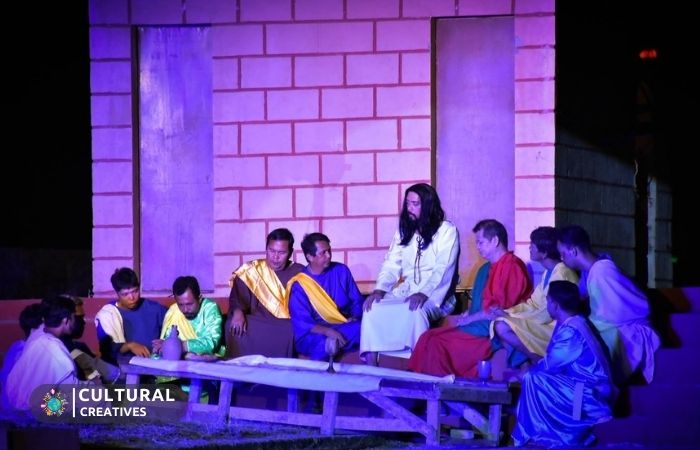
The Moriones Festival is not only a spectacle of faith and culture but also a showcase of exquisite artisanship embodied in its iconic masks. These handcrafted masks are central to the festival, representing the Roman soldiers in the context of the Passion of Christ. This section delves into the craftsmanship and artistry behind these masks, uncovering the intricate process of their creation, the personal stories of the local artisans, and the unwavering commitment to preserving tradition through craft.
The Process Of Mask Making
The journey of a Moriones mask begins with raw materials, primarily wood or papier-mâché. Artisans, with years of experience, meticulously carve and mold these materials to form the base structure. After the initial shaping, the masks undergo a series of refinements, including:
- Sanding for a smooth surface
- Applying a primer to prepare for painting
- Detailed painting, bringing the masks to life with expressive features
- Adding accessories, such as helmets and centurion plumes
A single mask can take weeks to complete, reflecting the dedication and skill of the mask maker.
Local Artisans And Their Stories
Behind every mask is a story of tradition and personal triumph. Local artisans from the island of Marinduque are the custodians of mask-making, often inheriting and honing their craft from generations before. Personal narratives bring color and depth to their work, with many artisans overcoming economic hardships and gaining respect within the community.
Meet Artisan Mang Juan (pseudonym):
| Name | Years of Experience | Signature Style |
|---|---|---|
| Mang Juan | 30 | Utilizes, contrasting colors and intricate carvings |
Mang Juan’s masks are known for their unique flair, attracting collectors and festival-goers alike. Each piece tells a tale, immortalizing his passion for the craft.
Preservation Of Tradition Through Craft
In a modern world where traditions can easily fade, the Moriones Festival’s mask-making persists as a living art. Artisans not only craft masks but also safeguard a cultural heritage, passing down knowledge and techniques. Schools and community workshops introduce younger generations to the craft, ensuring that the legacy of Moriones remains vibrant.
- Workshops teach mask-making to youth
- Exhibitions celebrate the history and evolution of mask design
- Fellowships support artisans in continuing their practice
Through these collective efforts, the artistry behind the masks maintains its timeless allure, captivating audiences and keeping the Moriones tradition alive for years to come.
Moriones Festival In The Modern Context
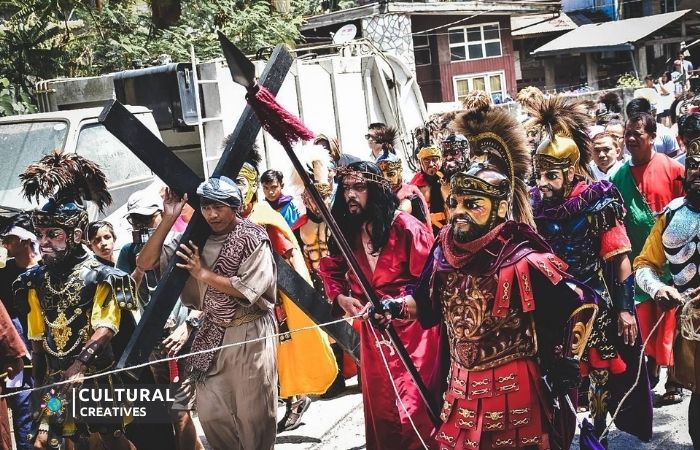
The Moriones Festival, a cultural gem from the heart of Marinduque, Philippines, remains a testament to the community’s rich history and religious devotion. As time ushers us further into the complexities of the modern world, this festival too has evolved to resonate with the contemporary backdrop. Its transformation involves adapting to current challenges and opportunities, balancing tradition with change, and reflecting broader societal themes – all while captivating tourists and bolstering the local economy.
Challenges Of Modernity And Commercialization
The Moriones Festival’s masks and costumes continue to tell Biblical tales, but beneath those masks lie questions of authenticity and commercial pressures in today’s world. Artisans and performers face a delicate tightrope walk between preserving the festival’s authenticity and adapting to the lucrative calls of modern tourism.
- An increase in souvenir-driven commodification
- Shifts in craftsmanship techniques due to available materials and audience expectations
- Balancing the sacred and the commercial aspects in festival events
Festival As A Platform For Social Issues
Beyond color and spectacle, the Moriones Festival has become a stage for addressing pertinent social issues. Participants don engaging costumes not just to reenact biblical scenes but to weave in narratives on pressing matters such as climate change, equality, and social justice.
Highlighted themes have included:
- Environmental conservation efforts in Marinduque
- Advocacy for equality and diversity
- Reflections on societal values and community wellbeing
Tourism And Economic Effects On The Local Community
Tourism sparked by the famous Moriones Festival leads to a significant economic influx in Marinduque. With thousands flocking to witness this cultural spectacle, its influence spans across various sectors:
| Economic Sector | Effects |
|---|---|
| Local Artisans | Boost in sales of traditional crafts and costumes |
| Accommodations | Increase in demand for hotels, resorts, and homestays |
| Food & Beverage | Growth in local dining establishments; showcase of native cuisine |
| Travel & Tourism | Rise in transport services, tour guides, and travel agencies |
With a surge in visitors, locals find entrepreneurial opportunities, yet must also consider the long-term sustainability of their natural and cultural resources.
Conclusion
Exploring the vivid tableau of the Moriones Festival reveals deep-rooted cultural splendor. This Philippine spectacle thrives on its lively traditions and colorful narratives. Embrace the fervor, artistry, and devotion encapsulated in this historical event. Join in and witness a unique blend of faith and festivity that continues to captivate and inspire visitors from around the globe.

